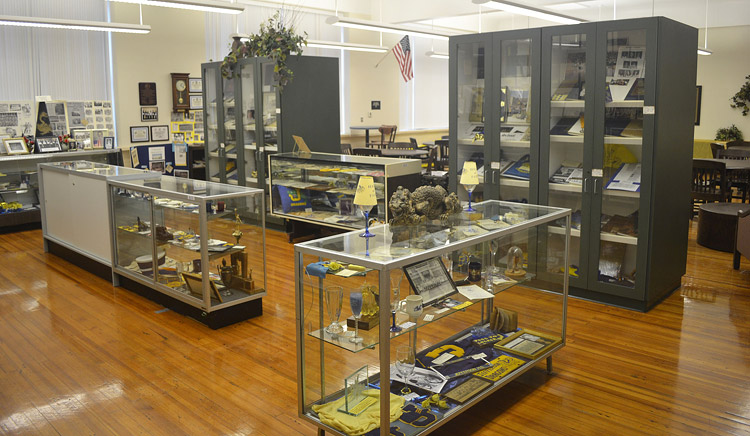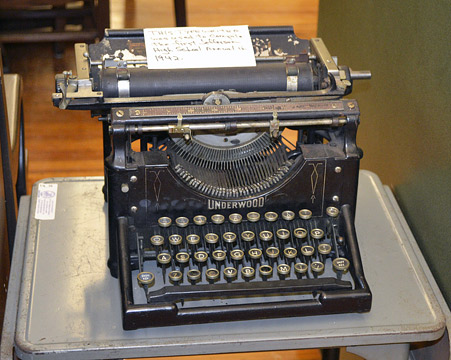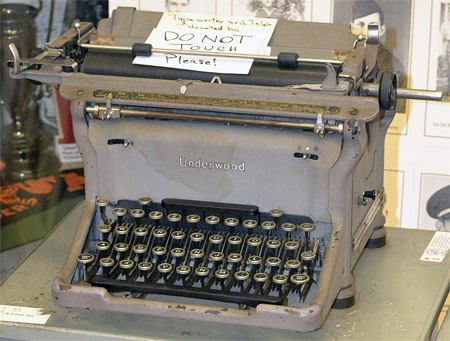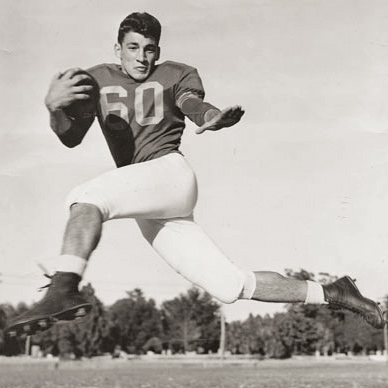|
|
|
|
|
At the D. W. Waters Career
Center, 2704 N. Highland Ave., Tampa |
||
|
|
|
|
|
At the D. W. Waters Career
Center, 2704 N. Highland Ave., Tampa |
||
|
After
Jefferson High School closed in 1967, the history of the school was
practically forgotten.
By 1993, the old building had some offices but was in dire condition. At that
time, through the efforts of Kay Moore Morse and Wynelle Davis Gilbert, a
museum was started. Through the great generosity of Jefferson
alumni, items were donated for the museum. Ample space for the
museum was provided in what used to be Mr. Waters office and the
secretary's office. To raise funds, a flea market was started in
part of it, selling to all who came there. Coffee was sold when
meetings were held there and a snack bar was opened for the workers who
had to leave the premises to eat. The funds raised were used to buy a
computer and desk for the Alumni Association and to pay for the historical
marker out front, among other things. |
|
|
During
the 2003 building renovations, a big trailer across the street was
set up to house the museum. Set up by Wynelle Davis Gilbert, Class
of '44, it was
much smaller than the museum space in the building and had only enough
room for one showcase. The flea market ceased to operate, but they
retained the snack bar sales. May Young, Class of '45 and Olga Quintana,
Class of '43, spent all summer working on the HHS annuals to alphabetize
them. May Young created digital lists of each class in order to keep track
of alumni. The museum now occupies the old library space from Hillsborough and Jefferson High Schools, which also serves as the D. W. Waters Career Center reading room. |
|
|
Museum curator Wynelle Davis Gilbert and Hillsborough HIgh School historian Rex Gordon |
|
|
|
The museum is open for visitors all school days during regular hours except holidays after signing in at Main Office. The Alumni workroom adjoining the museum, for sale of annuals and to give information, is only open the first Tuesday of each month 10am-1pm. Waters is a 12 month school. In the summer they are open MON-Thurs. Closed Fridays.
Entrance to the museum is on the 2nd floor from the main hallway.
|
|
A view
from the north end of the reading room looking southeast toward the
museum exhibits. Beyond the windows seen along the back wall is the Alumni workroom adjoining the museum, for sale of annuals and to give information. |
|
 |
A view
from the museum (south) end of the media center. The wall on the left is the back (west) wall of the original building before the 1923 expansion by M. Leo Elliott.
|
| The glass showcases in the center were donated by Manuel Tamargo, Class of '63, and the classes of 1943, 1944 and 1946. The one between the standing cabinets was found at an auction by Al Rosello for only $75. West Tampa Glass put glass doors on the center one for no charge, as Link Elozory was a JHS graduate. |
|
A view
of the showcases that are off camera to the left of the above photo, the
south end of the room. The showcases on the left were originally open-fronted bookcases from the old JHS library. They were enclosed with locking glass doors for use in the museum. See these bookcases in the library in 1962.
|
|
|
On top of the showcases above are the principals who served in this building when it was Hillsborough and Jefferson.
|
|
|
The tall showcases were specially made for the museum by the school system and are double sided. The one on the left is Old Jefferson and one on right is the New Jefferson. |
|
The museum has a small section devoted to items related to Hillsborough High School and George Washington Jr. High. The star attraction is the contents of the building's cornerstone which contained a copper box time capsule from 1911. All the items found inside were archivally protected by the University of South Florida when first removed from the copper box and up-to-date information was placed in a newly constructed box before resealing and replacing the cornerstone. New items placed in the time capsule before replacing the cornerstone circa 2004:
|
|
Read more about the contents of the cornerstone time capsule. |
|
|
|
|
|
This showcase exhibits some Jefferson Junior High items, which were the years 1928 to 1939. When the concrete paving was removed from the front yard, many artifacts from that time period, which you see at the perimeter of the case, were uncovered by the De Lotto Construction Company and donated to the museum on behalf of all the workers who made this building the beautiful school it is today. The can is "U.S. Aqua, Drinking Water". There is an inkwell, some milk bottles, salt/pepper shakers, and a brick from the old Hillsboro Hotel..
|
|
The first annual published by Jefferson High School was for its first graduating class--1942. At the right is a typing stand and Underwood typewriter from the typing class, the one used to type the annual.
|
|
 |
|
|
 |
|
|
More equipment from the typing class: a Monpop tabulating
machine and another Underwood typewriter |
||
|
|
|
|
|
|
|
A baseball sweater donated by Ray Perez, Class of 1962, and a football game program from Robinson Knights vs. Jefferson Dragons football game, 1962.
A
1959 City Champs manager's football jacket donated by Billy Polk,
Class of '61. |
|
|
|
|
|
|
|
|
Original seats from the auditorium. The new ones that were installed during the renovation were styled after these, but are wider to accommodate today's larger "student body." |
|
|
1946 cheerleader's megaphone donated by Jimmy Jones, Class of '48.
|
|
|
|
|
|
.
|
|
|
|
Rick Casares
Left to Right: Junior class VP Andrew Puleo, Secretary Gloria Gonzalez, and President Richard "Rick" Casares
|
|
|
Jefferson Dragons track team Rick Casares, back row, 5th from the right. Ernest Urso, back row, 4th from the left.
|
|
As the saying went in his high school years, Rick Casares
really
"took the rag off the bush."
He excelled in every sport he participated in and thereby
put Jefferson High School athletics on the map. Ricardo "Rick" José Casares was born in Tampa on July 4, 1931 to José and Eleanor Casares. In the 1930s, Rick's father was a barber and Eleanor worked as a waitress; they lived at 2807 10th Street. Rick's paternal grandparents, (José's parents) Ricardo and Concettina Casares, where cigar makers who came to the United States in 1888. They were from Spain and Italy, respectively, and lived on Laurel Street near downtown, Tampa. José lived with them, along with his brother Faustino, and sisters Amalia, Aurora and Manuela, until 1930 when he married Eleanor. Rick's mother, Eleanor, was a daughter of Francesco and Tillie Liachizzie (or Lachizzi), both natives of Italy who settled in Paterson, New Jersey where Eleanor was born. Rick's maternal grandfather (Eleanor's father) Francesco, was a hod carrier in the 1920s to 1940--a skilled laborer who carries supplies to brick layers and masons. Eleanor lived with her parents and sisters, Angelina and Cecelia, and brothers George and Carmen, in Paterson, NJ, up until 1930 when she married José Casares.
On Dec. 22, 1939, when Rick was 8 years old, his father José was killed in a gang-style murder. Eleanor quickly moved back to Paterson, New Jersey by the spring of 1940 with her son and daughter (Vivian) to live with her parents, Frank and Tillie Lachizzi, at 28 Redwood Ave.
White text below is from "Tampa's NFL Hero" by Paul Guzzo, Cigar City Magazine: Rick and his neighborhood friends in Paterson would regularly meet in parking lots throughout the city to do battle with other groups of neighborhood kids. Guns and other such weapons were never used, only fists. These fights were not fueled by hatred, but simply competition; they wanted to see who the toughest neighborhood was, and the large and athletic Casares never lost a fight for his crew. At the age of 15, he took his fighting ability from the streets into the ring when he won New Jersey’s Diamond Gloves 160-pound division, the state’s version of the Golden Gloves tournament. To do so, he had to defeat men in their early-20s, as there was not an age limit in the tournament, only weight classes. His performance was so impressive that it caught the eye of Lou Duva, who has trained numerous boxing champions over the years, including Pernell Whitaker and Evander Holyfield. Duva wanted to begin training Casares immediately, offering his mother a contract paying her $100 a week until her son turned 18 and could turn professional. This was a lot of money at the time, but Casares’ mother said no. She did not want her son fighting for a living. Casares rebelled against his mother. He began fighting in the street more. He stopped going to school. If his attitude did not change, his life would go nowhere. His mother, unsure how to handle her disobedient son, shipped him back to Tampa to live with his father's family on Ivy Street, (José's brother Faustino Casares and wife Violet.) Tampa had turned into a safer city than it was when they left and provided a more tranquil atmosphere for a teen to be raised. Information about Rick Casares from Wikipedia: At Jefferson High School in Tampa, Rick's teachers introduced him to high school sports as a way to keep him in school. The Jefferson coaches discovered the 190-pound, six-foot-one-inch freshman when he picked up a javelin for the first time and threw it. Casares played football, basketball, and baseball for the Jefferson Dragons, and he was also a track and field athlete. He was an all-state football and basketball player, and the Dragons won the city football championship in 1948 and 1949. In 1949, he was given the Guy Toph Award, which was awarded to the best player in Hillsborough County. “Rick was the best high-school athlete to ever come out of the state of Florida,'' Jefferson coach Dick Spoto once said. The Tampa Tribune recognized Casares as one the Tampa Bay area's 100 greatest athletes of the previous century in 1999. In 2007, fifty-seven years after he graduated from high school, the Florida High School Athletic Association (FHSAA) recognized him as one of the thirty-three all-time greatest Florida high school football players of the last 100 years by naming him to its "All-Century Team.
|
||||
| Rick Casares Junior year photos
|
||||
|
|
Jefferson Dragons baseball team Rick Casares on back row, 3rd from left. |
|||
|
|
||||
|
Jefferson Dragons basketball team, Rick Casares back row, 3rd from left, #32 |
||||
|
||||
|
|
||||
|
Jefferson Dragons football team - Rick Casares, front row, 4th from left, #60. |
||||
|
||||
|
|
Wilson (41) leads with blocking for Casares, (60). Against Plant City, the Dragons fell beind 6-0 early in the game on a touchdown pass by the Planters. Marino of the Dragons blocked the extra point attempt. The second half was played in a downpour. Late in the game, Casares took a punt return to his own 25 yard line, and after 10 plays, Sam Puleo knifed into the endzone for a Dragons touchdown to tie the game. Because of the rain, the Dragons opted to kick for the extra point. Instead, the ball was given to Rick Casares who plowed through the line for the extra point, giving the Dragons a victory. |
|||
|
|
|
|
Casares vs. Orlando |
Casares uses his physical strength and determination to plow for yards with two defenders on the tackle. |

Rick Casares, 1950 Jefferson Dragons
Photo from
March 2008 article by Paul Guzzo in Tampa's Cigar City Magazine:
"Tampa's NFL Hero"
After graduating from high school, Casares received an athletic scholarship to attend the University of Florida in Gainesville, Florida, and he played fullback for coach Bob Woodruff's Florida Gators football team from 1951 to 1953. Casares quickly became the star rusher of the Gators' backfield. As a 210-pound, six-foot-two-inch sophomore in 1952, he scored the first touchdown of the Gators' first bowl game, a 14–13 victory over the Tulsa Golden Hurricane in the January 1, 1953 Gator Bowl, and was a second-team All-Southeastern Conference (SEC) selection and an honorable mention All-American. In 1953, he was a team captain. Woodruff ranked Casares as the Gators' best back and one of their three best kickers of the 1950s. Casares was also a member of coach John Mauer's Florida Gators basketball team, and led the team in scoring and rebounding with 14.9 points and 11.3 rebounds as a sophomore in 1951–52 and 15.5 points and 11.5 rebounds as a junior in 1952–53. In basketball, he was a third-team All-SEC selection in 1952; as basketball team captain in 1953, he received second-team All-SEC honors. Casares' college career was cut short when he was drafted into the U.S. Army after his junior year. He was later inducted into the University of Florida Athletic Hall of Fame as a "Gator Great." As part of an article series for The Gainesville Sun in 2006, he was recognized as No. 37 among the top 100 players of the first 100 years of Florida Gators football.
Casares finished his professional career with the NFL's Washington Redskins in 1965, and in 1966 with the AFL's Miami Dolphins, receiving only limited carries in his final two seasons.
|
||||||||||||||||||
|
The Alumni Workroom
At the
south end of the museum is the Alumni workroom where one can look at and
purchase past HHS and JHS yearbooks.
The
Class of 1942, the first graduating class of JHS, donated all their
leftover funds to the museum in the amount of $1,000.00 when they planned
no more reunions. Tables, chairs and file cabinets were purchased
with the funds. Up until then the museum had a mishmash of furniture
so with this generous gift they bought everything new when they moved into
the newly restored school.
They also have for sale three Chamberlain Totems - 1968, 1969 and 1971. One HCC Satori, 1974, and one East Bay Warrior, 1983 The annuals in the photos at right and below are for viewing purposes only.
|
The Eight Homes
of Hillsborough High School
Cornerstone
history of Hillsborough High School
Jefferson High School and George Washington Jr. High
School History and the D.W. Waters Career Center
TampaPix Home